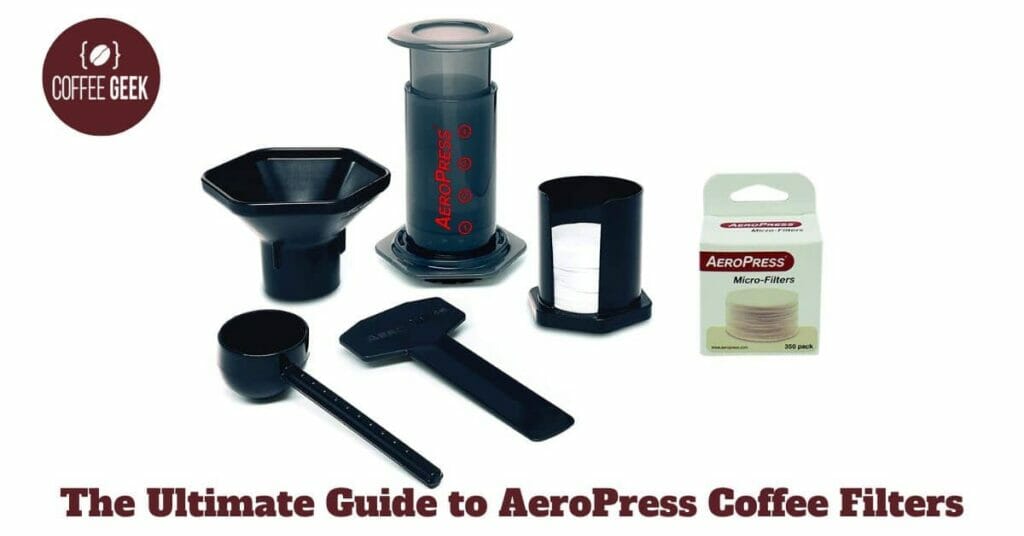How to Choose, Use and Hack This Overlooked Component of Your AeroPress Coffee Maker
If you’re a newbie to making coffee in an AeroPress, you may be wondering why you need to use filters in the first place. “Aren’t coffee filters for old-school coffee makers?”
Yes, they are! But they’re also a key component in getting your AeroPress to produce delicious coffee every time you use it.
Since AeroPress coffee filters aren’t exactly the most-discussed topic in the coffee universe, we went ahead and dedicated a full piece to it in the hopes of providing our readers with a single, comprehensive resource.
In this article, we’re going to answer all of your most pressing filter-related questions, such as:
What is the purpose of an AeroPress filter?
Which AeroPress filters are best: metal filters or paper filters?
How do you use and reuse them?
How many filters should you use with an AeroPress?
We’ll cover all that and more—hopefully answering all your questions along the way.
We’ll also pepper in some tips and tricks like how to save both money and the environment by reusing paper filters.
Plus we’ll cover how to make the best coffee possible by using paper filters in the first place!
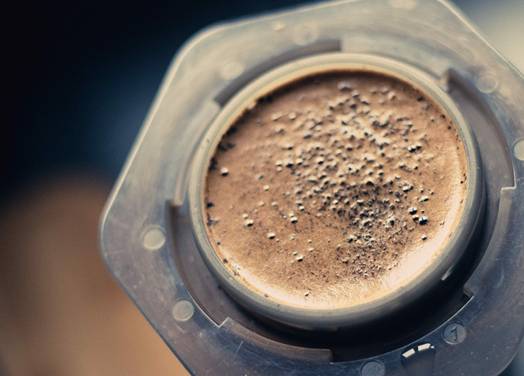
- Does the AeroPress Actually Need Filters?
- The Real Function of AeroPress Filters
- AeroPress Paper Filters or Metal Filters?
- Optimize Your AeroPress Filters for the Perfect Cup of Coffee
- Reusing Coffee Filters in Your AeroPress
- How to Clean a Reusable Metal Filter
- Wrap-Up: Using Filters in an AeroPress Coffee Maker
Does the AeroPress Actually Need Filters?
A valid question and a good place to start.
A good AeroPress coffee filter is an essential part of any home brewing machine.
Without one, the device simply wouldn’t function, and trying to use it sans-filter would essentially turn the AeroPress into an open tube that dumps coffee grinds and hot water into your cup.
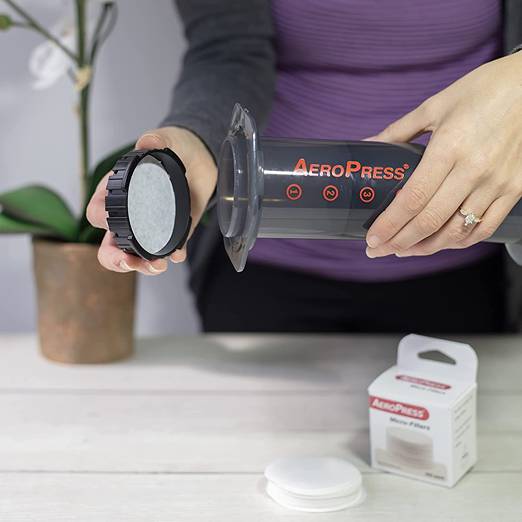
In AeroPress coffee makers, your filter functions much as it does inside French press coffee brewers, trapping ground coffee inside the coffee maker against a high-pressure flood of water that would otherwise send the grounds swirling into the coffee mix.
So yes, the AeroPress like nearly all coffee makers relies on coffee filters in order to brew that delicious coffee that likely motivated you to buy one in the first place.
The Real Function of AeroPress Filters
It’s not just about what gets the job done. In fact, the quality of your AeroPress coffee depends on the filters you use.
The flavor profile of your coffee will be affected by filter material, and in this case, size definitely matters.
Porosity for the Perfect Pour
The porosity of the filter plays a large role in the taste of your AeroPress coffee. Porosity refers to the size of the holes in an AeroPress filter.
Metal filters have larger pores, whereas paper ones have smaller ones.
Then there are AeroPress micro-filters which are designed to maximize the beneficial effects of small porosity.
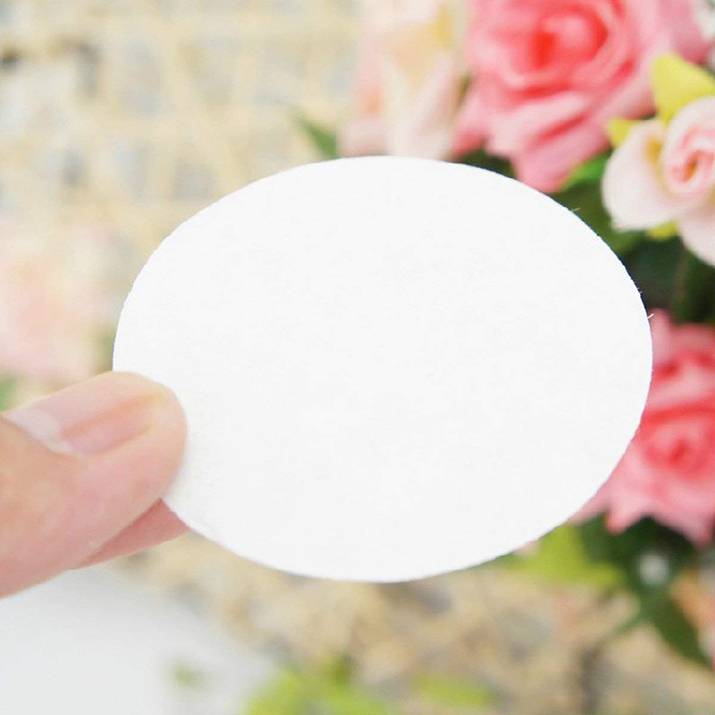
But it’s not as simple as it may seem from what we’ve described so far.
There are a surprising amount of factors in each type of filter, and many of the tradeoffs come down to individual taste.
Let’s lay out the differences so you can make the choice that’s right for you.
AeroPress Paper Filters or Metal Filters?
How to Choose the Best Tool for the Job
There are several factors to consider when buying a coffee filter for an AeroPress coffee maker.
For starters, the filters you choose should be high quality and reasonably priced.
Buying the cheapest filter will rarely work in your favor, and sometimes the best one is the most expensive.
That little uptick in quality from a moderately priced filter to the most expensive option isn’t always worth it for most people, but we definitely recommend against going cheap here.
This is the central component of your coffee maker, and every molecule of that smooth cup of delicious coffee you’re extracting with it flows through the filter.
Coffee made by even the best AeroPress coffee makers will vary depending on your filter choice, and at the top level, there are two types—metal filters and AeroPress paper filters.
While paper filters are reusable and recyclable, many people tend to assume they’re not.
While metal filters allow more oils to pass through, paper filters tend to retain less oil.
Aeropress Metal Filters
Metal filters for the AeroPress are made of stainless steel and therefore do not absorb the oils from your coffee, which results in a more concentrated flavor and higher caffeine content.
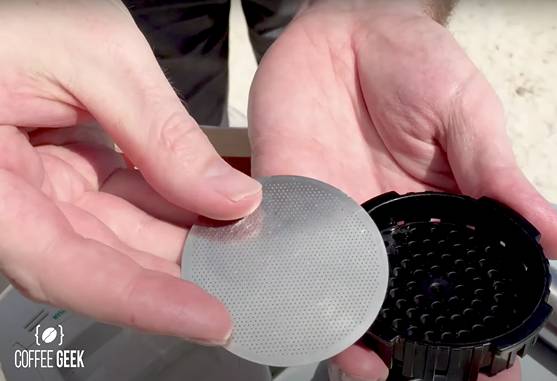
They’re also easy to clean, although over time they may become clogged with coffee residue.
If you don’t regularly clean your filter, it can actually start to break down and cause a cup of coffee to taste off.
So even though it’s seen as the more sustainable option, you’ll want to replace a metal filter every few months to avoid this problem.
When buying an AeroPress metal filter, you’ll want to read customer reviews. These reviews will give you unbiased information about the product’s quality and popularity.
A popular product is likely to be highly recommended. If a review doesn’t mention a problem, it may be worth ignoring.
Besides, a popular product is bound to be better than a cheap one. After all, a good cup of coffee is worth the cost!
Paper filters
Paper filters allow liquid to pass through while restricting oils.
Within the paper category, there’s a variety of porosity options, from standard all the way down to paper micro, which will affect the end result of your brew.
Paper filters are cheap and low maintenance. You can buy them in packs of a few hundred and they last for about two years.
Paper filters are, at their core, micro-filters that remove grit from your homebrew.
They are about 2.5 inches in diameter and are one of the main contributors to AeroPress coffee being so smooth and creamy.
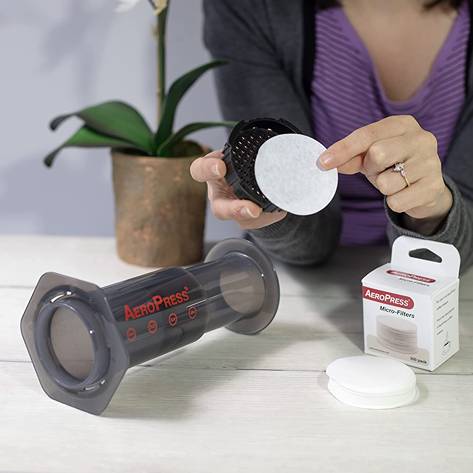
They can also be reusable, so you can save them and reuse them whenever you like. To reuse them, the filters should be thoroughly rinsed after each use.
You can either rinse the filter in the cap or in a conventional method by pouring hot water through it.
Rinsing the filter removes paper residue from the coffee and reduces the cardboard taste.
If you prefer not to reuse them, after you have finished using your AeroPress paper coffee filter, you can compost it.
We always recommend the unbleached paper for the cleanest, most natural brew.
Metal Mesh Filters
Metal mesh filters are considered a kind of “hybrid” between standard metal and paper filters. These are made of the same material as metal filters but are as flexible as paper.

They allow a bit more oil to pass through than paper does, whereas traditional paper tends to make your AeroPress coffee slightly less oily and more robust.
Depending on how much oil you want your AeroPress coffee to have, you can choose a metal mesh filter for your machine.
Optimize Your AeroPress Filters for the Perfect Cup of Coffee
Using Multiple Filters
If you’re getting serious about AeroPress coffee, you may be wondering how many filters you can use to get the most out of your new coffee maker and brew the most delicious cup possible.
Most people will be satisfied with one filter—either metal or paper—with a porosity that’s best suited to the full taste they’re after.
However, if you’re not sure, you can purchase a pre-filter.
When deciding how many filters you need for your AeroPress, make sure you think about your budget.
Standard paper filters are cheap, but you can upgrade to higher-end versions with metal disks.
Once you notice the impact on taste, you might be inclined to use slightly higher-end filters.
Stacking multiple layers of filters, including a pre-filter, can enable you to make some truly immaculate brews, but it will increase your cost-per-cup, and without a commitment to reuse, isn’t exactly environmentally friendly.
However, it’s worth noting that stacking filters in your AeroPress is still a pretty simple approach to brewing great coffee with minimal equipment—especially if you compare the quality-to-complexity ratio to an espresso machine.
Micro Filtered Coffee
The size of the paper filter matters because it will affect the flavor of your drink.
Paper filters are environmentally safe and biodegradable, so they are a good option for people who are concerned about the environment.
There are two standard sizes of AeroPress filters. Regular and large. The larger one fits the standard-size AeroPress coffee filter, while the smaller one is for a finer grind.
The regular size is used by most coffee drinkers because it tends to produce a delicious American coffee that resonates with the a broad sample of tastes.
The best cup for you, the thought may come down to other factors like fine-tuning porosity. That’s where micro filters come into play.
The smaller the porosity of your filters, the higher the purity and perceivable “smoothness” of your brew.
In metal and paper filters alike, smaller pores trap more sediment for a particle-free, low-oil, cup that true enthusiasts crave.
Reusing Coffee Filters in Your AeroPress
The benefits of purchasing a reusable filter are obvious. For starters, it means that you won’t have to spend money on new filters every time you want a cup of coffee.
Additionally, you’ll be able to enjoy a delicious coffee while staying environmentally friendly.
While AeroPress is known for its stainless steel reusable filter, a paper coffee filter is more eco-friendly and compostable when the time eventually comes to replace it.
What some people don’t realize is that it’s actually possible to reuse a paper filter over again. In fact, many people have reported reusing their filter for over 20 times.
How to Clean a Reusable Metal Filter
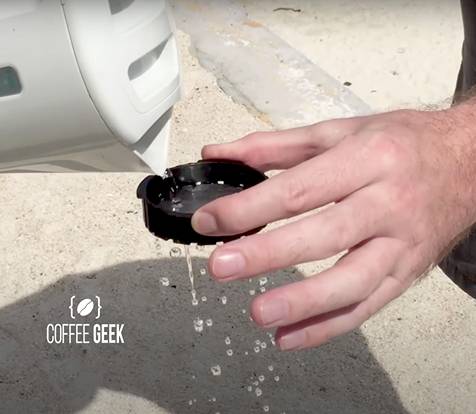
If you’re new to AeroPress, you might wonder how to clean the metal filter. While a paper filter might be easier to clean, a metal filter is more durable and will extract coffee quicker.
Using the AeroPress metal coffee filter is one of the easiest ways to enjoy great-tasting coffee at home.
Its simple design makes it an easy piece to clean.
All you need to do is hold the filter under running water and use a soft brush to remove the accumulated coffee grounds and smell.
One great thing about this product is that it is very durable and can last for many months.
Wrap-Up: Using Filters in an AeroPress Coffee Maker
This may seem like a good amount of work, but caring for your coffee filters from purchase through preparation and reuse is a remarkably simple way to get some great coffee out of your AeroPress.
When you consider that this simple little device can [make (~) mouth-watering] cold brew, a great cup of simple French press-style coffee, and even rival an espresso maker in brewing a full-body cup of coffee, it’s a no-brainer to fine-tune your coffee with some care toward your filters.
Especially when you consider the complexity and relative effort needed to use and maintain an espresso maker and other coffee makers, putting the right filters in your AeroPress is an incredibly easy way to get the most out of this innovative coffee press.

